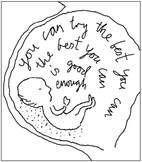The work shares its title with a project that has occupied the artist for more than a decade. This involves the recreation of thousands of artefacts looted from Iraq's National Museum following the US-led invasion of 2003. These substitutes are fashioned from food packaging or local newspapers and displayed alongside explanatory labels in both English and Arabic. Whilst the presentation of these bargain-basement treasures mimic museum methods, closer inspection reveals both the mundane materials and unconventional texts. A case in point is a missing fluted beaker made of gold. The replacement consists of strips of metal from date syrup cans and a display card that includes an extract from comments made by Donald Rumsfeld during a news briefing held on April 11, 2003. The United States Secretary of Defense angrily dismissed accusations that he lacked a plan to tackle lawlessness in Iraq and instead sought to deflect criticism by characterising the anarchy and looting that was then taking place as the understandable release of pent-up anger targeted at the deposed regime of Saddam Hussein. Rumsfeld then went on to make a notorious quip that Rakowitz repeated in his museum label:
The images you are seeing on television you are seeing over, and over, and over, and it's the same picture of some person walking out of some building with a vase, and you see it 20 times, and you think, "My goodness, were there that many vases?" [Laughter.] "Is it possible that there were that many vases in the whole country?" (cited in Mockaitis 2012: 147).
Thanks to Rakowitz, one of those innumerable looted objects lives on, albeit in a new form. His act of reverse alchemy – turning gold into redundant food packaging – provides a precursor to the work that can now be seen in Trafalgar Square. It metamorphoses a winged bull known as a lamassu, specifically an Assyrian sculpture dating from about 700BC that served as a protective deity at the Nergal Gate leading to the city of Nineveh. In 2015 it fell victim to Islamic State (ISIL or Daesh) militants during their occupation of Mosul. They took a drill to the bull's face and bored out its eyes. The Iraqi archaeologist, Lamia al-Gailani found this an especially telling act, paralleling the insult 'gulla abut ainak', meaning 'I'm going to poke your eyes out' (cited in BBC 2016). Rakowitz's reference to an unseen foe in The Invisible Enemy Should Not Exist is thus particularly apposite. It is also fitting that the dimensions of the Lamassu are commensurate with the Fourth Plinth, which was designed to accommodate an equestrian statue. Its presence amidst the other monuments has the potential to trigger intriguing parallels. Rakowitz, for example, pointed out that some of the bronze elements of Nelson's Column were cast using metal from cannons salvaged from the wreck of HMS Royal George (National Gallery 2017; cf. Mace 2005: 97; Ward-Jackson 2011: 279). This chimed with his own recycling. The London Lamassu has been constructed of empty cans of date syrup, just like the surrogate vase looted from Iraq's National Museum. This is intended as a deliberate reference to a once thriving industry crippled by war and insecurity:
There used to be 30m date palms in Iraq when it was the leading exporter of dates in the world in the 70s. After the Iran-Iraq war it fell to 16m, and since the 2003 invasion it is less than 3m. The hope is that this project intersects not only the cultural tragedy but the human tragedy and the ecological tragedy, so it becomes an effigy for all those things [that] it haunts. It is supposed to be a ghost more than a reconstruction (Rakowitz cited in Brown 2017).
Trafalgar Square is a haunt replete with monumental ghosts of empire. It is thus a conducive milieu for the insertion of a further, intentional apparition.
-----
For a longer discussion of Rakowitz's The Invisible Enemy Should Not Exist in the context of the destruction of the Arch of Palmyra in Syria in 2015, see:
Burch, Stuart (2017) "A Virtual Oasis: Trafalgar Square's Arch of Palmyra", ArchNet-IJAR: International Journal of Architectural Research. Special Issue: Architectural and Urban Heritage in the Digital Era, vol. 3, no. 3, 2017, pp. 58-77
References
BBC (2016). Museum of lost objects: Winged-Bull of Nineveh. BBC Radio 4, February 29. Retrieved
February 27, 2017 from http://www.bbc.co.uk/programmes/b071skph.
Brown, M. (2017). Fourth plinth shortlist includes winged bull and giant cream blob. The Guardian, January
19. Retrieved February 27, 2017 from https://www.theguardian.com/artanddesign/2017/jan/19/fourthplinth-
shortlist-trafalgar-square-winged-bull.
Mace, R. (2005). Trafalgar Square emblem of empire. London: Lawrence & Wishart.
Mockaitis, T.R. (2012) (Ed.). Document 40: Excerpt of Secretary of Defense Donald Rumsfeld and General
Richard B. Myers, Department of Defense News Briefing, April 11, 2003. In T.R. Mockaitis (Ed.). The
Iraq War: A Documentary and Reference Guide (145-151). Santa Barbara, CA: Greenwood Press.
National Gallery (2017). Fourth plinth shortlist exhibition. National Gallery, Annenberg Court, January 19 –
March 26.
Ward-Jackson, P. (2011). Public sculpture of historic Westminster: Volume 1. Liverpool: Liverpool University
Press.






